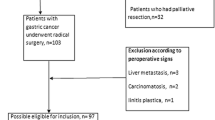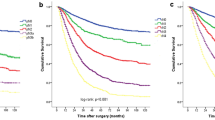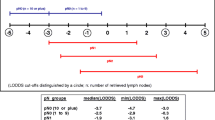Abstract
Background
Lymph node metastasis is considered one of the most important prognostic factors in gastric cancer. However, the optimal system for accurate staging of lymph node metastasis for patients with gastric cancer remains controversial. This study was designed to investigate the prognostic significance of the metastatic lymph node ratio (MLR), which is calculated by dividing the number of metastatic lymph nodes by the total number of nodes harvested from patients with gastric cancer.
Methods
We retrospectively analyzed the clinical data of 186 consecutive patients diagnosed with gastric cancer who underwent curative gastrectomy at our hospital. The lymph node status was classified according to three systems: the International Union Against Cancer/American Joint Committee on Cancer (UICC/AJCC) system; the Japanese Gastric Cancer Association (JGCA) system; and an MLR-based system (MLR0: 0, MLR1: 0.01–0.19, MLR2: ≥0.2). The influence of the MLR on patient survival was determined using univariate Kaplan-Meier survival analysis, the generalized Wilcoxon test, and analysis with the multivariate Cox proportional hazards model.
Results
The 5-year survival rate of the patients with MLR0, MLR1, and MLR2 was 88.6%, 59.4%, and 13.4%, respectively. In addition to the MLR, the UICC/AJCC N category, JGCA n category, tumor stage (pT category), and tumor diameter significantly influenced the 5-year survival rate, as determined by univariate analysis. Multivariate analyses revealed that of the three factors used to stage lymph node involvement, MLR was the most significant prognostic factor.
Conclusions
The MLR is an important and easy-to-assess prognostic factor that should be considered for staging lymph node metastasis in patients with gastric cancer.

Similar content being viewed by others
References
Adachi Y, Kamakura T, Mori M et al (1994) Prognostic significance of the number of positive lymph nodes in gastric carcinoma. Br J Surg 81:414–416
Yokota T, Ishiyama S, Saito T et al (2004) Lymph node metastasis as a significant prognostic factor in gastric cancer: a multi logistic regression analysis. Scand J Gastroenterol 39:380–384
Wu ZY, Li JH, Abe S et al (2007) Effect of lymph node micrometastases on prognosis of gastric carcinoma. World J Gastroenterol 13:4122–4125
Japanese Gastric Cancer Association (1998) Japanese classification of gastric carcinoma, 2nd English edition. Gastric Cancer 1:10–24
Sobin LH, Fleming ID (1997) TNM classification of malignant tumors, Fifth edition Union Internationale Contre le Cancer and American Joint Committee on Cancer. Cancer 80:1803–1804
Nitti D, Marchet A, Olivieri M et al (2003) Ratio between metastatic and examined lymph nodes is an independent prognostic factor after D2 resection for gastric cancer: analysis of a large European monoinstitutional experience. Ann Surg Oncol 10:1077–1085
Bando E, Yoneyama Y, Taniguchi K et al (2002) Outcome of ratio of lymph node metastasis in gastric carcinoma. Ann Surg Oncol 9:775–784
Inoue K, Nakane Y, Iiyama H et al (2002) The superiority of ratio-based lymph node staging in gastric carcinoma. Ann Surg Oncol 9:27–34
Ozgüc H, Sönmer Y, Yerci O (2008) Metastatic/resected lymph nodes ratio-based classification in gastric cancer. Turk J Gastroenterol 19:2–7
Saito H, Fukumoto Y, Osaki T et al (2008) Prognostic significance of the ratio between metastatic and dissected lymph nodes (n ratio) in patients with advanced gastric cancer. J Surg Oncol 97:132–135
Persiani R, Rausei S, Biondi A et al (2008) Ratio of metastatic lymph nodes: impact on staging and survival of gastric cancer. Euro J Surg Oncol 34:519–524
Huang CM, Lin BJ, Lu HS et al (2008) Prognostic impact of metastatic lymph node ratio in advanced gastric cancer from cardia and fundus. World J Gastroenterol 14:4383–4388
Yamaguchi T (2003) JGCA gastric cancer treatment guideline: a new trend in gastric cancer treatment. Jpn Medical Association J 46:238–245
Ichikura T, Tomimatsu S, Uefuji K et al (1999) Evaluation of the New American Joint Committee on Cancer/International Union against cancer classification of lymph node metastasis from gastric carcinoma in comparison with the Japanese classification. Cancer 86:553–558
Fujii K, Isozaki H, Okajima K et al (1999) Clinical evaluation of lymph node metastasis in gastric cancer defined by the fifth edition of the TNM classification in comparison with the Japanese system. Br J Surg 86:685–689
Hemaneck P (2000) The superiority of the new International Union Against Cancer and American Joint Committee on Cancer TNM staging of gastric carcinoma. Cancer 88:1763–1765
Hundahl SA, Phillips JL, Menck HR (2000) National Cancer Data Base report on poor survival of U.S. gastric carcinoma patients treated with gastrectomy: Fifth Edition American Joint Committee on Cancer staging, proximal disease, and the “different disease” hypothesis. Cancer 88:921–932
Okusa T, Nakane Y, Boku T et al (1990) Quantitative analysis of nodal involvement with respect to survival rate after curative gastrectomy for carcinoma. Surg Gynecol Obstet 170:488–494
Siewert JR, Bottcher FK, Stein HJ, Roder JD (1998) Relevant prognostic factors in gastric cancer: ten-year results of the German Gastric Cancer Study. Ann Surg 228:449–461
Yu W, Choi GS, Whang J et al (1997) Comparison of five systems for staging lymph node metastasis in gastric cancer. Br J Surg 84:1305–1309
Wagner PK, Ramaswamy A, Schmitz-Moormann P et al (1991) Lymph node counts in the upper abdomen: anatomical basis for lymphadenectomy in gastric cancer. Br J Surg 78:825–827
Kodera Y, Yamamura Y, Shimizu Y et al (1998) Lymph node status assessment for gastric carcinoma: is the number of metastatic lymph nodes really practical as a parameter for N categories in the TNM classification? J Surg Oncol 69:15–20
Author information
Authors and Affiliations
Corresponding author
Rights and permissions
About this article
Cite this article
Fukuda, N., Sugiyama, Y., Midorikawa, A. et al. Prognostic Significance of the Metastatic Lymph Node Ratio in Gastric Cancer Patients. World J Surg 33, 2378–2382 (2009). https://doi.org/10.1007/s00268-009-0205-1
Published:
Issue Date:
DOI: https://doi.org/10.1007/s00268-009-0205-1




